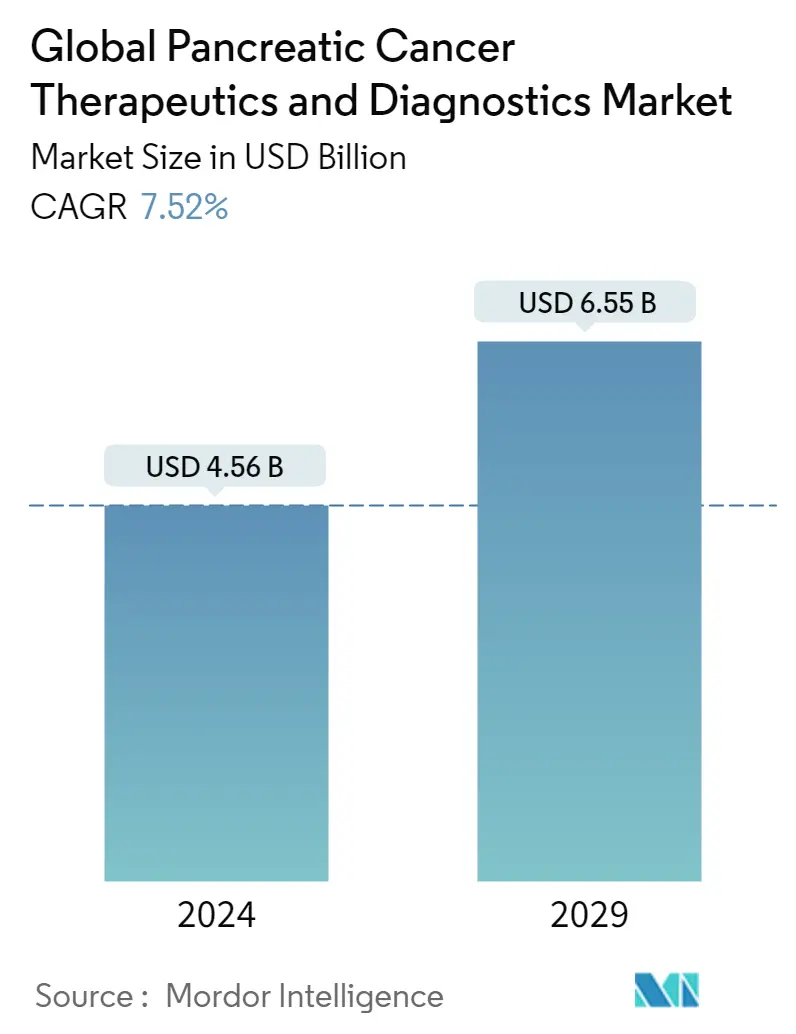
| Study Period | 2019 - 2029 |
| Base Year For Estimation | 2023 |
| Market Size (2024) | USD 4.56 Billion |
| Market Size (2029) | USD 6.55 Billion |
| CAGR (2024 - 2029) | 7.52 % |
| Fastest Growing Market | Asia Pacific |
| Largest Market | North America |
Major Players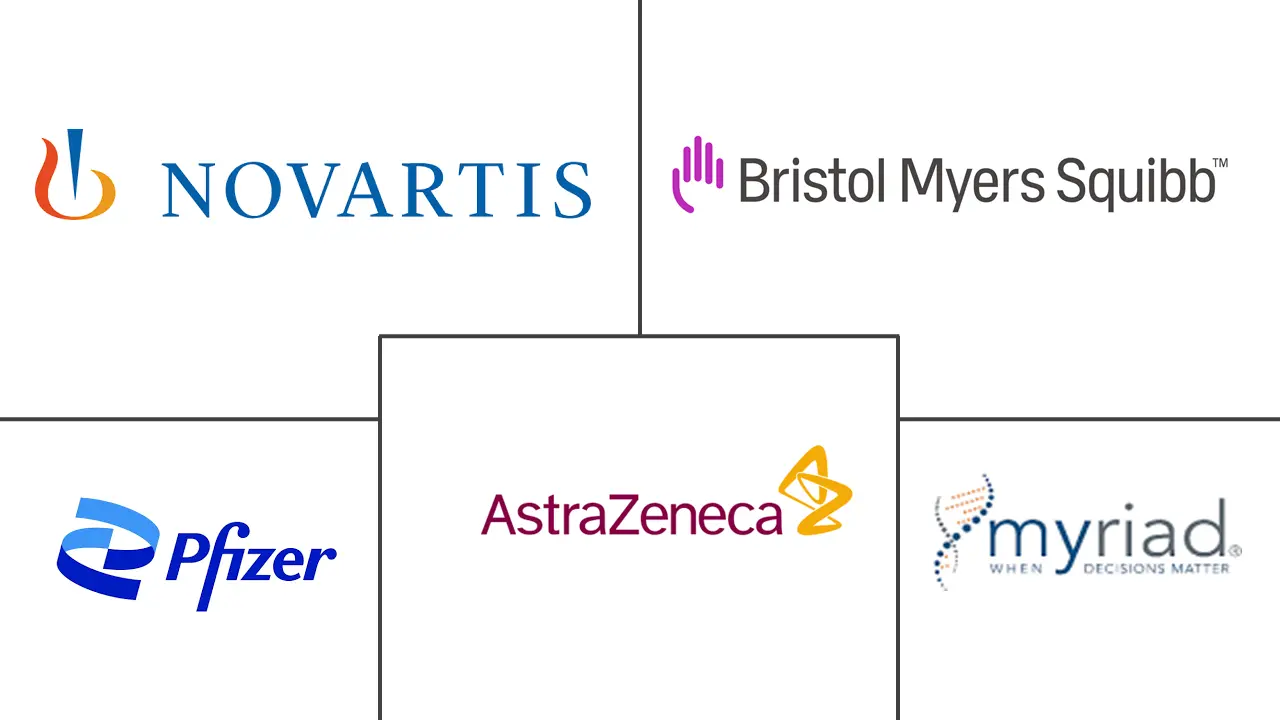
*Disclaimer: Major Players sorted in no particular order |
Pancreatic Cancer Therapeutics & Diagnostics Market Analysis
The Global Pancreatic Cancer Therapeutics and Diagnostics Market size is estimated at USD 4.56 billion in 2024, and is expected to reach USD 6.55 billion by 2029, growing at a CAGR of 7.52% during the forecast period (2024-2029).
The outbreak of COVID-19 significantly reduced hospital and healthcare services, impacting the pancreatic cancer therapeutics and diagnostics market. Moreover, the COVID-19 pandemic affected the global economy and showed a huge impact on the functioning of general hospital care for non-COVID-19 patients in hospitals. In June 2020, an article appearing in the National Center for Biotechnology Information studied the impact of the COVID-19 pandemic on the use of endoscopy units globally. The study looked into 55 countries across 6 continents from April 23 to May 12, 2020. The study found that the number of endoscopy procedures performed during the COVID-19 pandemic decreased, constituting an 83% reduction compared to the baseline figures. The study also found out that there was an 82% reduction in upper endoscopy procedures and an 85% reduction in lower endoscopy procedures during the same time. In August 2020, a survey was published in PubMed on the impact of COVID-19 on pancreatic surgery for cancer patients. The survey was conducted amongst 337 respondents from 267 centers from 37 countries. According to the survey, most centers performed fewer pancreatic surgeries due to the COVID-19 pandemic, which reduced the weekly pancreatic resection rate from 3 to 1. Thus, the COVID-19 pandemic is expected to impact the studied market's growth significantly.
Pancreatic cancer therapeutics and diagnostics involve medical procedures used to diagnose pancreatic cancer and subsequent treatment. Factors such as the increasing prevalence and incidence of pancreatic cancer and advancements in molecular biology, development of drugs, and diagnostic technology play a major part in market growth. With the increase in R&D initiatives, favorable reimbursement scenarios, and the launch of novel products, the market is expected to grow significantly during the forecast period. In January 2019, scientists from the Van Andel Research Institute (VARI) developed a novel blood test (CA19-9 test) that, when combined with an existing test, can detect nearly 70% of pancreatic cancers with a less than 5% of false-positive rate. Moreover, in January 2021, Myriad Genetics Inc. announced that it would receive reimbursement for its BRACAnalysis Diagnostic System, which is also used for pancreatic cancer screening from Japan's Ministry of Health, Labour, and Welfare. The initiative is expected to increase the patient pool for genetic testing for pancreatic cancer in Japan. Also, many collaborations are taking place in the market, which is expected to affect market development positively. In October 2020, Oncolytics Biotech Inc. announced a collaboration with Roche and AIO for a phase 1/2 trial of testing the efficacy of pelareorep and atezolizumab in the treatment of metastatic pancreatic cancer. Thus, these developments are expected to impact the studied market growth over the forecast period positively.
Pancreatic Cancer Therapeutics & Diagnostics Market Trends
The Chemotherapy Segment is Expected to Witness a Major Share in the Studied Market Over the Forecast Period
Chemotherapy is one of the main cancer treatments that kill pancreatic cancer cells by preventing them from growing and dividing. These drugs are systemic treatments; the drugs travel through the bloodstream and damage cancer cells throughout the body. Unfortunately, chemotherapy can damage some healthy cells and cause major side effects. Chemotherapy may shrink and/or prevent the growth of pancreatic tumors. According to the American Cancer Society, the chemotherapy drugs used to treat pancreatic cancer include Gemcitabine (Gemzar), 5-fluorouracil (5-FU), Irinotecan (Camptosar), Oxaliplatin (Eloxatin), Albumin-bound paclitaxel (Abraxane), Capecitabine (Xeloda), Cisplatin, Paclitaxel (Taxol), Docetaxel (Taxotere), and Irinotecan liposome (Onivyde).
Since the 1990s, the chemotherapy drug gemcitabine (Gemzar) has been the backbone of treating people with pancreatic cancer that can be removed with surgery (resectable). Traditionally, gemcitabine has been given as adjuvant chemotherapy after the patient has recovered from the surgery, which, for many patients, is a grueling procedure known as the Whipple procedure. More recently, gemcitabine is sometimes combined with the chemotherapy drug capecitabine (Xeloda). Chemotherapy may also be given alone or combined with surgery, targeted therapy, immunotherapy, and/or radiation. When chemotherapy is given in combination with radiation, a low dose of chemotherapy is typically used. The chemotherapy drugs most commonly used in conjunction with radiation therapy are fluorouracil (5-FU) and gemcitabine (Gemzar). 5-FU is used most often since there is more experience using this drug in combination with radiation, and there are fewer side effects.
In March 2020, the Pancreatic Cancer Collective, the strategic partnership of the Lustgarten Foundation and Stand Up To Cancer (SU2C), was awarded up to USD 16 million to four teams of top researchers, including a team at Dana-Farber Cancer Institute, as part of its New Therapies Challenge Grants, the American Association for Cancer Research (AACR), and Scientific Partner of SU2C. Nearly USD 4 million in funding is available to help support three pancreatic cancer clinical trials testing DNA repair inhibitors combined with chemotherapy. Thus, due to the surging demand for effective treatment options for pancreatic cancers, the studied segment is expected to witness significant growth over the forecast period.
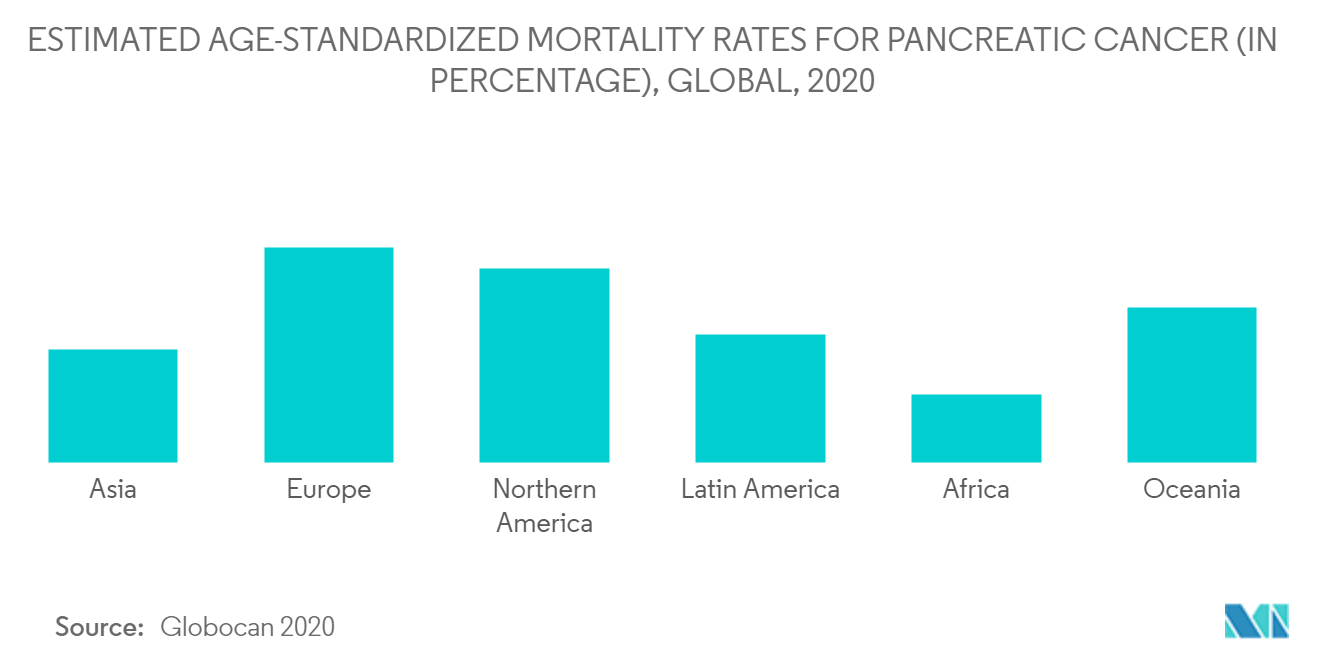
North America Dominated the Overall Market and is Expected to Retain its Dominance
The United States is expected to retain its significant market share due to the rising incidence of pancreatic cancers, supportive reimbursement policies, and high healthcare spending.
As per a 2018 publication in the MedCrave Gastroenterology and Hepatology journal, pancreatic cancer was the ninth most frequent cancer, despite its moderate incidence. It was expected to be among the second-deadliest cause of cancer by 2030. Also, according to the GLOBOCAN 2020 report, about 56,654 new cases of pancreatic cancer were reported in 2020. Moreover, approximately 47,683 deaths due to pancreatic cancer were reported in the United States. The USFDA is also taking steps to enhance the growth of the pancreatic cancer therapeutics and diagnostic market by approving drugs in the clinical phase, thereby accelerating clinical developments. Companies and research organizations are investing in R&D. Thus, the market is expanding quickly. For instance, in 2020, ERYTECH's lead product candidate, eryaspase, received the fast track designation by the FDA due to the urgent need for potential new treatment options for patients with second-line metastatic pancreatic cancer in the country. Such product approvals by the FDA are expected to lift the overall market.
In 2020, NANOBIOTIX announced its first phase I trial with NBTXR3 in Pancreatic Cancer, which is safe to proceed as per the US FDA. The trial was co-developed with Nanobiotix, and MD Anderson is the sponsor and executor of the trial. These clinical trials' positive outcomes will result in a new treatment, positively influencing the regional market growth. Thus, owing to the factors mentioned above, the studied market is anticipated to register significant growth over the forecast period in the region.
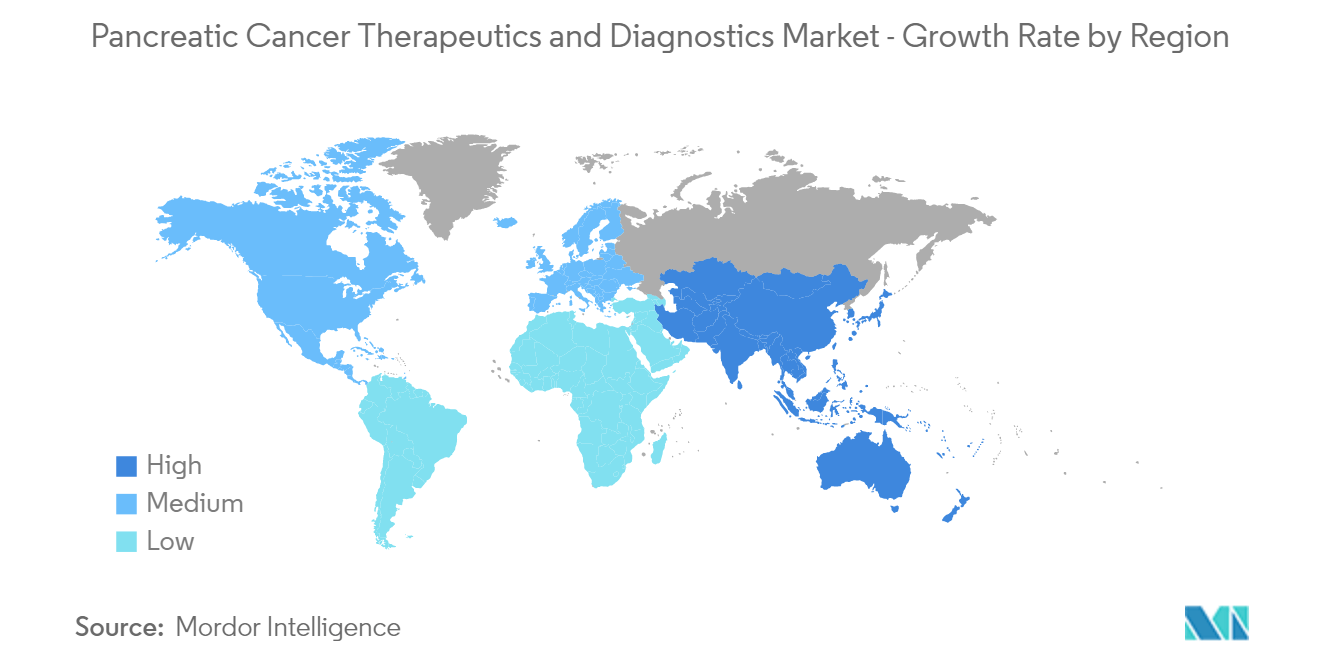
Pancreatic Cancer Therapeutics & Diagnostics Industry Overview
The Pancreatic Cancer Therapeutics and Diagnostics market is highly competitive, with many key players dominating the market. The presence of major market players like Novartis AG, Pfizer Inc., Bristol-Myers Squibb Company, AstraZeneca PLC, Myriad Genetics Inc., and Viatris Inc. is intensifying the competition. The market players are adopting strategies, such as rising R&D investments, mergers, acquisitions, and product innovations, to sustain the increasing market rivalry. For instance, in January 2021, Myriad Genetics Inc. entered into a strategic partnership with Illumina Inc. for the latter to create a kit-based version of the myChoice companion diagnostic (CDx) test for international markets, which can be used to detect pancreatic cancer.
Pancreatic Cancer Therapeutics & Diagnostics Market Leaders
-
Myriad Genetics, Inc.
-
Pfizer, Inc
-
Novartis AG
-
Bristol-Myers Squibb Company
-
AstraZeneca plc
- *Disclaimer: Major Players sorted in no particular order
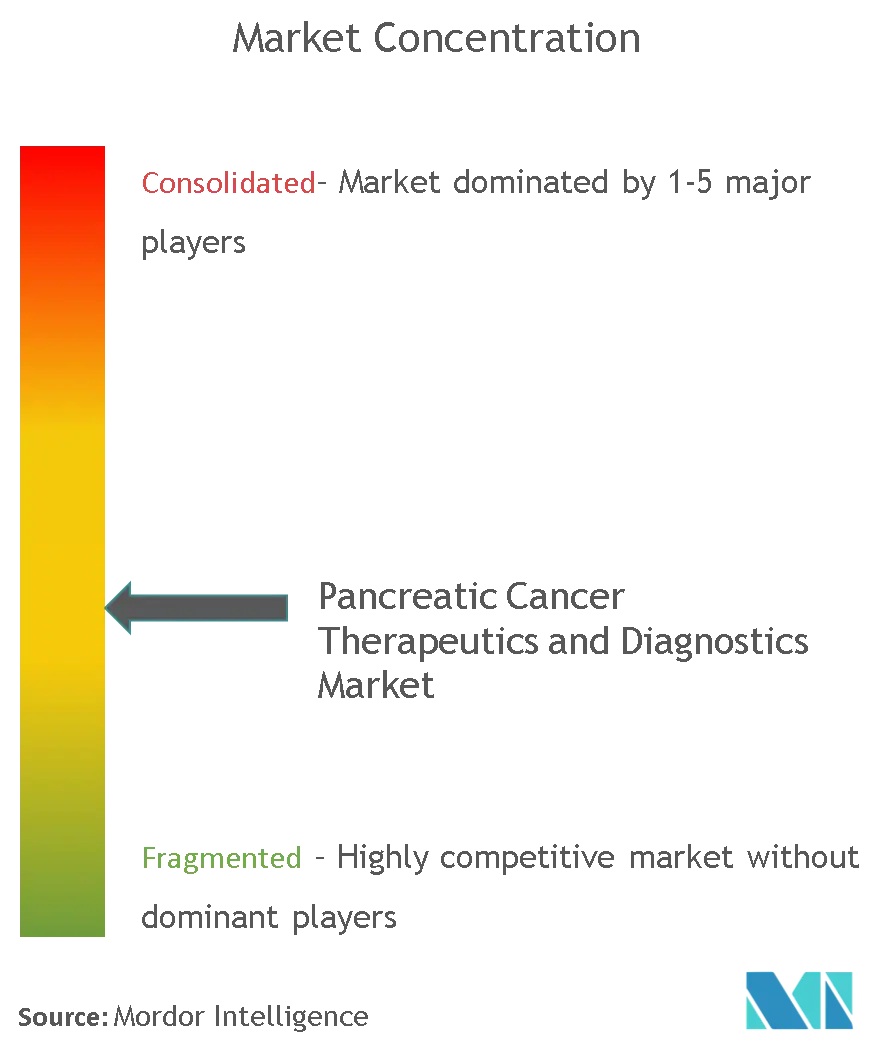
Pancreatic Cancer Therapeutics & Diagnostics Market News
In October 2020, Apexigen Inc. obtained the US Food and Drug Administration (FDA) grant of orphan drug designation status to its APX005M, a humanized monoclonal antibody that stimulates the anti-tumor immune response for the treatment of esophageal and gastroesophageal junction cancer and the treatment of pancreatic cancer.
In July 2020, AstraZeneca and Merck's Lynparza drug received approval in the European Union for patients with pancreatic cancer after chemotherapy whose tumors harbor germline BRCA1/2 mutations.
Pancreatic Cancer Therapeutics & Diagnostics Industry Segmentation
Pancreatic cancer occurs when there is an uncontrollable growth of cells in the pancreas. Pancreatic cancer is categorized as exocrine and endocrine, based on the cells affected by cancer. Exocrine cells in the pancreas create pancreatic enzymes. When cancer manifests in these cells, it is referred to as exocrine pancreatic cancer. Endocrine cells are a small cluster of cells and are also called islets of Langerhans. These cells create hormones, such as insulin and glucagon, releasing them into the blood flow. Cancer in these cells is called endocrine pancreatic cancer. The pancreatic cancer therapeutics and diagnostics market is segmented by Type (Treatment (Targeted Therapies, Chemotherapy, Surgery, and Other Treatments) and Diagnostics (Imaging, Biopsy, Endoscopic Ultrasound, and Other Diagnostics)) and Geography (North America, Europe, Asia-Pacific, Middle-East and Africa, and South America). The market report also covers the estimated market sizes and trends for 17 countries across major regions globally. The report offers the value (in USD million) for the above segments.
| By Type | By Treatment | Targeted Therapies |
| Chemotherapy | ||
| Surgery | ||
| Other Treatments | ||
| By Type | By Diagnostics | Imaging |
| Biopsy | ||
| Endoscopic Ultrasound | ||
| Other Diagnostics | ||
| Geography | North America | United States |
| Canada | ||
| Mexico | ||
| Geography | Europe | United Kingdom |
| Germany | ||
| France | ||
| Italy | ||
| Spain | ||
| Rest of Europe | ||
| Geography | Asia-Pacific | China |
| Japan | ||
| India | ||
| Australia | ||
| South Korea | ||
| Rest of Asia-Pacific | ||
| Geography | Middle-East and Africa | GCC |
| South Africa | ||
| Rest of Middle-East and Africa | ||
| Geography | South America | Brazil |
| Argentina | ||
| Rest of South America |
Pancreatic Cancer Therapeutics & Diagnostics Market Research FAQs
How big is the Global Pancreatic Cancer Therapeutics and Diagnostics Market?
The Global Pancreatic Cancer Therapeutics and Diagnostics Market size is expected to reach USD 4.56 billion in 2024 and grow at a CAGR of 7.52% to reach USD 6.55 billion by 2029.
What is the current Global Pancreatic Cancer Therapeutics and Diagnostics Market size?
In 2024, the Global Pancreatic Cancer Therapeutics and Diagnostics Market size is expected to reach USD 4.56 billion.
Who are the key players in Global Pancreatic Cancer Therapeutics and Diagnostics Market?
Myriad Genetics, Inc., Pfizer, Inc, Novartis AG, Bristol-Myers Squibb Company and AstraZeneca plc are the major companies operating in the Global Pancreatic Cancer Therapeutics and Diagnostics Market.
Which is the fastest growing region in Global Pancreatic Cancer Therapeutics and Diagnostics Market?
Asia Pacific is estimated to grow at the highest CAGR over the forecast period (2024-2029).
Which region has the biggest share in Global Pancreatic Cancer Therapeutics and Diagnostics Market?
In 2024, the North America accounts for the largest market share in Global Pancreatic Cancer Therapeutics and Diagnostics Market.
What years does this Global Pancreatic Cancer Therapeutics and Diagnostics Market cover, and what was the market size in 2023?
In 2023, the Global Pancreatic Cancer Therapeutics and Diagnostics Market size was estimated at USD 4.24 billion. The report covers the Global Pancreatic Cancer Therapeutics and Diagnostics Market historical market size for years: 2019, 2020, 2021, 2022 and 2023. The report also forecasts the Global Pancreatic Cancer Therapeutics and Diagnostics Market size for years: 2024, 2025, 2026, 2027, 2028 and 2029.
Our Best Selling Reports
Pancreatic Cancer Therapeutics & Diagnostics Industry Report
Statistics for the 2024 Pancreatic Cancer Therapeutics & Diagnostics market share, size and revenue growth rate, created by Mordor Intelligence™ Industry Reports. Pancreatic Cancer Therapeutics & Diagnostics analysis includes a market forecast outlook to 2029 and historical overview. Get a sample of this industry analysis as a free report PDF download.




